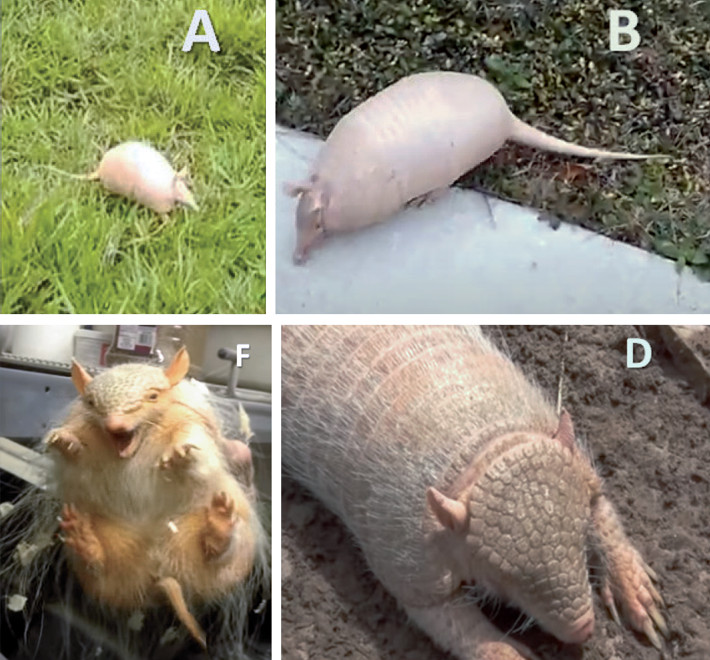Anormalidades cromáticas en armadillos (Xenarthra: Cingulata): registros hallados en la web
DOI:
https://doi.org/10.31687/SaremNMS23.8.4Palabras clave:
albinismo, Chaetophractus, Dasypus, leucismoResumen
El albinismo, leucismo y melanismo son las anormalidades cromáticas más registradas por lo raras y/o llamativas que son. El objetivo de esta nota es presentar cuatro nuevos registros de anormalidades cromáticas en armadillos obtenidos por la comunidad. Se registraron un caso de albinismo y otro de leucismo en Dasypus novemcinctus, un caso de albinismo en Chaetophractus villosus y otro de albinismo en Chaetophractus vellerous. Estas aberraciones cromáticas serían poco frecuentes en armadillos, debido principalmente a estrategias reproductivas que evitarían la endogamia y por lo tanto la pérdida de diversidad genética.
Citas
Abba, A. M., et al. 2023. El piche llorón (Chaetophractus vellerosus) en el Parque Costero del Sur, distintos aspectos sobre su ecología, comportamiento, genética y conservación. Parque Costero del Sur, Vol. II (J. Athor, ed.). Fundación de Historia Natural «Félix de Azara», Buenos Aires.
Abreu, M. S. L., R. Machado, F. Barbieri, N. S. Freitas, & L. R. Oliveira. 2013. Anomalous colour in Neotropical mammals: a review with new records for Didelphis sp. (Didelphidae, Didelphimorphia) and Arctocephalus australis (Otariidae, Carnivora). Brazilian Journal of Biology 73:185–194.
Almeida, A. K. R., F. H. Menezes, & H. Fernandes-Ferreira. 2022. First record of albinism in a cavy of the genus Galea Meyen, 1832 (Rodentia: Caviidae). Notas Sobre Mamíferos Sudamericanos 4:e22.3.3. https://doi.org/10.31687/saremNMS.22.3.3.
Araújo Xavier, G. A., R. A. Mota, & M. A. Borstelmann de Oliveira. 2010. Marcação ungueal em preguiças-de-garganta-marrom Bradypus variegatus (Schinz, 1825) de vida livre na Estação Ecológica de Caetés, Paulista-PE, Brasil. Edentata 11:18–21. https://doi.org/10.1896/020.011.0104.
Binns, L. A., W. J. Loughry, C. M. McDonough, C. D. Anderson, & J. Light. 2020. Spatial genetic structure within a population of nine-banded armadillos in western Mississippi. Journal of Mammalogy 101:143–150. https://doi.org/10.1093/jmammal/gyz174
Bôlla, D., J. P. Baraldo-Mello, T. Garcia, & S. Rovito. 2022. Color abnormalities in the giant anteater (Myrmecophaga tridactyla Linnaeus, 1758) and southern tamandua (Tamandua tetradactyla [Linnaeus, 1758]) from Brazil and Ecuador. Notas sobre Mamíferos Sudamericanos 4:e22.11.2. https://doi.org/10.31687/SaremNMS22.11.2.
Caro, T., & R. Mallarino. 2020. Coloration in mammals. Trends in Ecology & Evolution 35: 357–366.
Cotts, L., & S. B. Serodio Prestes. 2022. First report and description of melanism and albinism in giant anteater, Myrmecophaga tridactyla (Xenarthra, Myrmecophagidae). Oecologia Australis 26:637–645. https://doi.org/10.4257/oeco.2022.2604.11.
Lopes A. C. P. A, E. Junior, M. A. de Freitas, & K. Molina. 2019. Primeiro registro de leucismo em Bradypus variegatus (Schinz 1825, Xenarthra: Bradypodidae), município de Maceió, Alagoas, Brasil. Edentata 20:39–43. https://doi.org/10.2305/iucn.ch.2019.edentata-20-1.8.en.
Eizirik, E., & F. J. Trindade. 2021. Genetics and evolution of mammalian coat pigmentation. Annual Review of Animal Biosciences 9:125–148.
Kühlhorn, F. 1940. Ein Fall von Melanismus bei der Gürtelmaus (Chlamydophorus truncatus). Zoologischer Anzeiger 132:191–193.
Landis, M. B., et al. 2020. First record of albino lowland tapirs (Tapirus terrestris Linnaeus, 1758) in an important Brazilian Atlantic Forest hotspot. Mammalia 84:601–604. https://doi.org/10.1016/10.1515/mammalia-2019-0084.
LaPergola, J. B. 2019. First record of albinism in the nine-banded armadillo (Dasypus novemcinctus). Caribbean Naturalist 64:1–5.
Leroux, M., et al. 2022. First observation of a chimpanzee with albinism in the wild: social interactions and subsequent infanticide. American Journal of Primatology 84:e23305. https://doi.org/10.1002/ajp.23305.
Loughry, J. W, & C. M. McDonough. 2013. The nine-banded armadillo. A natural history. University of Oklahoma Press, Oklahoma.
Macnaghten, H. 1918. On white elephants. Journal of the Bombay Natural History Society 26:285–286.
McDonough, C. M. 2000. Social organization of nine-banded armadillos (Dasypus novemcinctus) in a riparian habitat. American Midland Naturalist 144:139–151. https://doi.org/10.1674/0003-0031(2000)144[0139:SOONBA]2.0.CO;2.
McNab, B. K. 1980. Energetics and the limits to a temperate distribution in armadillos. Journal of Mammalogy 61:606–627.
Menegaux, M. A. 1902. Catalogue des mammifères rapportés par M. Geay de la Guyane Française en 1889 et 1900. Bulletin du Muséum d'Histoire Naturelle, Paris 8:490–496.
More, A., J. Vallejos, I. Sánchez, J. Vallejos, R. P. Piana, & R. D. Appleton. 2021. Registro de coloración anormal del oso hormiguero norteño Tamandua mexicana (Saussure, 1860) y notas sobre su límite sur de distribución. Revista Peruana de Biología 28:e19759. https://doi.org/10.15381/rpb.v28i1.19759.
Nardelli, M., et al. 2016. Genetic structuring in a relictual population of screaming hairy armadillo (Chaetophractus vellerosus) in Argentina revealed by a set of novel microsatellite loci. Genética 144:469–476.
Nardelli, M., Ibañez, E., Dobler, D., Illia, G., Abba, A. M., & J. I. Túnez. 2020. Genetic approach reveals a polygynous-polyandrous mating system and no social organization in a small and isolated population of the screaming hairy armadillo, Chaetophractus vellerosus. Genetica 148:125–133. https://doi.org/10.1007/s10709-020-00092-5.
Novaes, R. L. M. 2020. Melanism in Bradypus variegatus (Pilosa, Bradypodidae). Notas Sobre Mamíferos Sudamericanos 2:e20.0.37. https://doi.org/10.31687/saremNMS.20.0.37.
Pelaez-Tapia, Y., J. R. Ayerbe, A. Portillo, & L. Mamani. 2021. Primer reporte de albinismo en vizcacha Lagidium viscacia (Rodentia: Chinchillidae) en los Andes de Perú. Revista Peruana de Biología 28:e21136 http://dx.doi.org/10.15381/rpb.v28i3.21136.
Rice, A. A., et al. 2022. First photographic record of albinism in Baiomys taylori (Rodentia: Cricetidae). Mammalia 86:239–242 https://doi.org/10.1515/mammalia-2021-0120.
Ríos, A. S. D., B. C. R. Díaz, & C. P. Smith. 2019. Reporte de un ejemplar albino de Tamandua tetradactyla (Linnaeus, 1758) (Pilosa, Myrmecophagidae) en el suroeste de Paraguay. Edentata 20:35–38. https://doi.org/10.15560/6.1.052.
Ríos-Alvear, G., & H. Cadena-Ortiz. 2019. Records of melanistic Tamandua tetradactyla (Pilosa, Myrmecophagidae) from Ecuador. Neotropical Biology and Conservation 14:339–347.
Santos, P. M., et al. 2019. Neotropical Xenarthrans: a dataset of occurrence of Xenarthran species in the Neotropics. Ecology 100:e02663. https://doi.org/10.1002/ecy.2663.
Standley, P. C. 1921. Albinism in the black bear. Science 54:74.
Strecker, J. K. 1927. A possible albino armadillo? Journal of Mammalogy 8:60.
Stroman, G. 1925. An albino coyote. Journal Of Heredity 16:342–343.
Superina, M. 2000. Biologie und Haltung von Gürteltieren (Dasypodidae) in Institut für Zoo-, Heim- und Wildtiere. Universität Zürich, Zürich. p. 250.
Van Grouw, H. 2021. What's in a name? Nomenclature for colour aberrations in birds reviewed. Bulletin of the British Ornithologists' Club 141:276–299. https://doi.org/10.25226/bboc.v141i3.2021.a5.

Descargas
Publicado
Cómo citar
Número
Sección
Licencia
Derechos de autor 2023 Jorge Alberto Gallo, Noralí Pagnutti, María Cecilia Chiale, Agustín Manuel Abba

Esta obra está bajo una licencia internacional Creative Commons Atribución-NoComercial 4.0.

